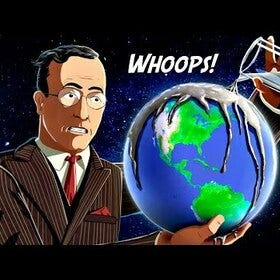#16: DIY Toaster, Dobby, Netflix Yarn Intro, Leaded Gasoline, Noise Pollution, Human Genome, Leaded Gasoline, and more!
Hi everyone!
A lot has happened in the past month, but the most interesting bit of news is that Elon Musk bought Twitter. I guess everyone must have a hobby?
I’m not very active on social media, but I do flick through Twitter on a daily basis. It’ll be interesting to see how the platform will change under his leadership. I’m also curious to see if they’ll improve Revue, the service that powers this newsletter.
In the meantime, I’m renovating part of the house to transform it into Simply Explained HQ! The new office will be small, but will have a lot of natural light and a lot of smart devices. Stay tuned for a blog post about this!
Enjoy this edition of the newsletter!
Xavier
📽 Entertaining videos
Building a toaster from scratch
In the previous newsletter, I mentioned the iPhone Thought Experiment, which asks: how long would it take to make an iPhone from scratch? Thomas Thwaites did exactly this! He built his own toaster from scratch by mining iron, mica, copper and plastic. The end results is…. special…
Netflix intro with $30 worth of yarn
Kevin Parry re-created the iconic intro of Netflix with a bunch of yarn. It surprised me he could match the original so closely! For those who are interested, check out the behind-the-scenes video.
The Man Who Accidentally Killed The Most People In History
The latest Veritasium video tells the story of Thomas Midgley Jr. During his lifetime he invented leaded gasoline (which prevented engine knocking) and CFC’s (which replaced poisonous gases in fridges). However, both had profound impacts on us and our environment. Leaded gasoline affects the brain and is estimated to have “cost” the world over 800 million IQ points. And CFC’s caused the hole in Earth’s ozone layer.
Environmental historian John Robert McNeill said that Midgley “had more impact on the atmosphere than any other single organism in Earth’s history.”
🤓 Cool Stuff I Found on the Internet
Dobby's grave is too popular
There are concerns about the environmental impact of the ‘grave’, with one person asking ‘why a CGI character is shown more respect than our countryside’
Museum of endangered sounds
Cool website that has audio records of old electronics equipment and computer technologies. Forgot how Nokia ringtone, Tamagotchi or ICQ sounded? Now you can re-experience them!
The Man No Prison Could Hold
One evening, I was reading up on the (successful?) Alcatraz escape attempt, and found this story from a resourceful inmate in Japan who broke out of 4 prisons. He picked a lock with a metal wire, climbed copper walls to escape through the roof of his cell, corroded handcuffs by spitting soup on it, and even dug his way out of a high security cell! The key takeaway from this story is: where there’s a will, there’s a way!
Production, use, and fate of all plastics ever made
This paper looks at all plastics ever produced and what happened to them when thrown away. The study estimates that we have produced 8300 million metric tons of plastic waste. Only 9% of that was recycled, 12% was incinerated and a massive 79% ended up on a landfill. Recycling plastic is tough, but a lot of research is being done on this subject. One idea is to use special enzymes to break down plastics into their building blocks (mentioned in issue #12).
🏥 Health & Medicine
Noise pollution hurts the heart
About a third of Americans and Europeans are regularly exposed to high sound levels (70-80dB). A new study found a link between noise and heart-related problems. When sound reaches our brains, it activates two regions: the auditory cortex, which interprets the noise, and the amygdala which manages the emotional response to sound. As noise gets louder, the amygdala activates the fight-or-flight response, which constricts arteries, increases blood pressure, slows digestion, and floods the blood with sugars & fats.
The human genome is complete (again)
The Human Genome Project was completed in 2003 and gave us access to the “full” human genome. Except, it only sequenced 85% of our DNA, ignoring the parts that were hard to sequence and believed to be junk DNA without function. Now, the missing parts have been sequenced, and it’s believed that these could play a role in conditions where cell division is messed up (such as cancer).
Blue-eyed humans have single, common ancestor
Researchers from the University of Copenhagen have found that all people with blue eyes have a common ancestor that lived between 6000 and 10,000 years ago. Blue eyes exist because of a mutation in the OCA2 gene which controls the amount of melanin in the iris. It’s a “neutral mutation” because having blue eyes is neither positive nor negative, but it shows that nature is constantly experimenting with our genome and figuring out the best way forward.




